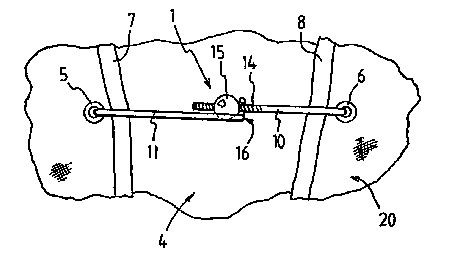Some of the information on this Web page has been provided by external sources. The Government of Canada is not responsible for the accuracy, reliability or currency of the information supplied by external sources. Users wishing to rely upon this information should consult directly with the source of the information. Content provided by external sources is not subject to official languages, privacy and accessibility requirements.
Any discrepancies in the text and image of the Claims and Abstract are due to differing posting times. Text of the Claims and Abstract are posted:
| (12) Patent Application: | (11) CA 2336555 |
|---|---|
| (54) English Title: | FOOTWEAR FASTENINGS |
| (54) French Title: | DISPOSITIF DE FERMETURE POUR CHAUSSURES |
| Status: | Deemed Abandoned and Beyond the Period of Reinstatement - Pending Response to Notice of Disregarded Communication |
| (51) International Patent Classification (IPC): |
|
|---|---|
| (72) Inventors : |
|
| (73) Owners : |
|
| (71) Applicants : |
|
| (74) Agent: | SMART & BIGGAR LP |
| (74) Associate agent: | |
| (45) Issued: | |
| (86) PCT Filing Date: | 2000-05-23 |
| (87) Open to Public Inspection: | 2000-12-07 |
| Availability of licence: | N/A |
| Dedicated to the Public: | N/A |
| (25) Language of filing: | English |
| Patent Cooperation Treaty (PCT): | Yes |
|---|---|
| (86) PCT Filing Number: | PCT/GB2000/001970 |
| (87) International Publication Number: | GB2000001970 |
| (85) National Entry: | 2001-01-03 |
| (30) Application Priority Data: | ||||||
|---|---|---|---|---|---|---|
|
An item of footwear has an opening (4) for insertion of a wearer's foot and a
pair of rigid fastening elements (10) and (11) for drawing together opposite
sides of the opening. The first element (10) has a screw thread (14) to
receive a bead (15), and the free end of the second element (11) is bent
orthogonally and formed into a U-shapedhook (16). When the wearer has placed
his/her foot into the boot the element (10) is placed over the mouth of the
hook (16). By applying gentle finger pressure the bead (15) is caused to ride
over the shank of the second element (11) so that the hook (16) embraces the
first element (10) and engages behind the bead (15). The tension in the
fastening can be adjusted by screwing the bead (15) along the thread (14). The
fastening is easy to engage and disengage when the wearer's fingers are cold
or when wearing heavy gloves, yet the fastening is secure enough to be used
with snowboarding or ski boots.
Une chaussure possède une ouverture (4) pour l'introduction du pied de l'utilisateur et une paire d'éléments de fermeture rigides (10 et 11) destinés à tirer l'un vers l'autre les côtés opposés de l'ouverture. Le premier élément (10) possède une partie filetée (14) servant à recevoir une bille (15) et l'extrémité libre du second élément (11), qui est incurvée perpendiculairement, possède un crochet (16) en forme de U. Lorsque l'utilisateur a placé son pied dans la chaussure, l'élément (10) est placé sur l'ouverture du crochet (16). L'application d'une légère pression du doigt sur la bille (15) fait passer cette dernière sur la tige du second élément (11) si bien que le crochet (16) vient entourer le premier élément (10) et vient en contact avec ce dernier derrière la bille (15). La tension du dispositif de fermeture peut être réglée par vissage de la bille (15) sur la partie filetée. Ledit dispositif de fermeture est facile à ouvrir et à fermer lorsque l'utilisateur a les doigts gourds ou quand il porte des gants épais, mais il est suffisamment sûr pour être utilisé avec des chaussures de surf des neiges ou de ski.
Note: Claims are shown in the official language in which they were submitted.
Note: Descriptions are shown in the official language in which they were submitted.

2024-08-01:As part of the Next Generation Patents (NGP) transition, the Canadian Patents Database (CPD) now contains a more detailed Event History, which replicates the Event Log of our new back-office solution.
Please note that "Inactive:" events refers to events no longer in use in our new back-office solution.
For a clearer understanding of the status of the application/patent presented on this page, the site Disclaimer , as well as the definitions for Patent , Event History , Maintenance Fee and Payment History should be consulted.
| Description | Date |
|---|---|
| Application Not Reinstated by Deadline | 2004-05-25 |
| Time Limit for Reversal Expired | 2004-05-25 |
| Deemed Abandoned - Failure to Respond to Maintenance Fee Notice | 2003-05-23 |
| Inactive: Cover page published | 2001-04-04 |
| Inactive: First IPC assigned | 2001-04-01 |
| Inactive: Notice - National entry - No RFE | 2001-03-20 |
| Inactive: Inventor deleted | 2001-03-20 |
| Application Received - PCT | 2001-03-19 |
| Application Published (Open to Public Inspection) | 2000-12-07 |
| Abandonment Date | Reason | Reinstatement Date |
|---|---|---|
| 2003-05-23 |
The last payment was received on 2002-05-21
Note : If the full payment has not been received on or before the date indicated, a further fee may be required which may be one of the following
Patent fees are adjusted on the 1st of January every year. The amounts above are the current amounts if received by December 31 of the current year.
Please refer to the CIPO
Patent Fees
web page to see all current fee amounts.
| Fee Type | Anniversary Year | Due Date | Paid Date |
|---|---|---|---|
| Basic national fee - small | 2001-01-03 | ||
| MF (application, 2nd anniv.) - small | 02 | 2002-05-23 | 2002-05-21 |
Note: Records showing the ownership history in alphabetical order.
| Current Owners on Record |
|---|
| STEVEN JOHN CULVERWELL |
| Past Owners on Record |
|---|
| None |